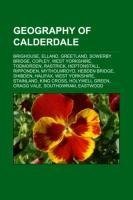
Geography of Calderdale
Source: Wikipedia. Pages: 42. Chapters: Brighouse, Elland, Greetland, Sowerby Bridge, Copley, West Yorkshire, Todmorden, Rastrick, Heptonstall, Ripponden, Mytholmroyd, Hebden Bridge, Shibden, Halifax, West Yorkshire, Stainland, King Cross, Holywell Green,... Viac o knihe
Produkt je dočasne nedostupný
15.66 €
bežná cena: 17.80 €
O knihe
Source: Wikipedia. Pages: 42. Chapters: Brighouse, Elland, Greetland, Sowerby Bridge, Copley, West Yorkshire, Todmorden, Rastrick, Heptonstall, Ripponden, Mytholmroyd, Hebden Bridge, Shibden, Halifax, West Yorkshire, Stainland, King Cross, Holywell Green, Cragg Vale, Southowram, Eastwood, West Yorkshire, Sowerby, West Yorkshire, Clifton, West Yorkshire, Norland, West Yorkshire, Lightcliffe, Illingworth, West Yorkshire, Warley Town, Hipperholme, Luddenden, Walsden, Old Town, West Yorkshire, Northowram, Shelf, West Yorkshire, Cornholme, Barkisland, Skircoat Green, Ovenden, Norwood Green, West Yorkshire, Upper Calder Valley, Luddendenfoot, West Vale, Mankinholes, Sowood, West Yorkshire, Mixenden, Chiserley, Ogden, West Yorkshire, Bailiff Bridge, Salterhebble, Boothtown, Hebden Royd, Midgley, Sowerbyshire, Walshaw Dean Reservoirs, Shibden valley. Excerpt: Halifax is a minster town, within the Metropolitan Borough of Calderdale in West Yorkshire, England. It has an urban area population of 82,056 in the 2001 Census. It is well-known as a centre of England's woollen manufacture from the 15th century onward, originally dealing through the Halifax Piece Hall. Halifax is internationally famous for its Mackintosh chocolate and toffee (now owned by Nestlé), the Halifax Bank (formerly Halifax Building Society), and the nearby Shibden Hall. The oldest written mentions of the town have the spelling as Haliflax, apparently meaning "holy flax" (Hair), the second "l" having been subsequently lost by dissimilation. Local legend has it that the head of John the Baptist was buried here after his execution. The legend is almost certainly medieval rather than ancient, though the town's coat of arms still carries an image of the saint. An alternative explanation for the name of the town could come from a corruption of the Old English/Old Norse words Hay and Ley for 'hay' and 'field' respectively. Anecdotal evidence for this alternative and plausible explanation can be seen in the presence of Haley Hill, the nearby hamlet of Healey (another corruption). The fact that the surnames Hayley/Haley which are derived from Hay and Ley and are most abundant around the Halifax environs, also gives credibility for this explanation. George Montagu-Dunk, 2nd Earl of HalifaxThe Earldom of Halifax took the name of the town. The first creation, in the Peerage of England in 1677, was for William Savile, 1st Viscount Halifax. He had already been made Baron Savile of Eland and Viscount Halifax in 1668 and was later made Marquess of Halifax (this creation of the earldom became extinct in 1700; see Marquess of Halifax for more information). George Montagu-Dunk, 2nd Earl of Halifax, (2nd order of the 3rd creation) became the President of the Board of Trade in 1748. In 1749 he helped to found the town (later city) of Halifax, the capital of Nova Scotia, Cana
- Vydavateľstvo: Books LLC, Reference Series
- Formát: Paperback
- Jazyk:
- ISBN: 9781156143926




 Nemecký jazyk
Nemecký jazyk 
 Anglický jazyk
Anglický jazyk 






